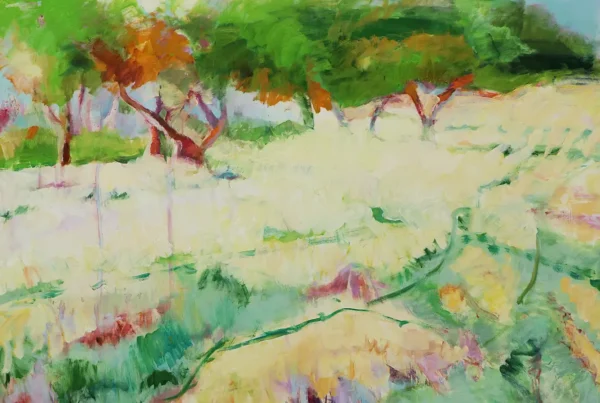A Transient Childhood and Its Artistic Roots
Diedrick Brackens‘ journey into the world of art began in the small town of Mexia, Texas, where he was born. His early years were marked by constant movement due to his father’s military career, which had the family relocating between various Army bases. This nomadic lifestyle exposed Brackens to a variety of cultures and environments, each leaving an indelible mark on his perspective and artistic sensibilities. The rich tapestry of experiences from these formative years would later influence his artistic vision, particularly in the medium of weaving.
Brackens’ first encounter with weaving occurred during his Bachelor of Fine Arts studies at the University of North Texas in Denton. It was here that the intricate process and vibrant possibilities of weaving captivated him, setting the stage for what would become his primary medium of artistic expression. This pivotal discovery not only shaped his creative direction but also provided a profound sense of connection to the material and cultural narratives he would explore in his work.
His academic journey continued with a Master of Fine Arts from the California College of the Arts, where he studied under renowned textile artist Josh Faught. Faught’s exploration of queer identity resonated deeply with Brackens, inspiring him to investigate his own themes of African American heritage and queer identity. This educational foundation equipped Brackens with both the technical prowess and conceptual depth necessary to develop his distinctive voice in the art world.

Diedrick Brackens: Interweaving Identity and Heritage
Diedrick Brackens’ woven tapestries are a vivid tapestry of his personal experiences and the broader narratives of African American and queer identities. Drawing inspiration from African and African American literature, poetry, and folklore, Brackens crafts pieces that are rich in cultural significance. His work melds techniques from West African weaving, Southern quilting traditions, and European tapestry-making, creating a unique blend that reflects his diverse influences.
Central to Brackens’ work is the use of cotton, a material deeply entwined with the history of the transatlantic slave trade and his own ancestral roots. By utilizing cotton, he imbues his tapestries with layers of meaning, addressing the historical and cultural contexts of Black identity. Through his art, Brackens seeks to illuminate the complexities of African American heritage and the intertwined narratives of oppression, resilience, and cultural significance.
His tapestries are not just visual representations but narrative devices that weave together mythology, religion, and historical events. This layering of symbols allows Brackens to create works that resonate on both a personal and universal level. Each piece is meticulously crafted, balancing figuration and abstraction to tell stories that are both intimate and expansive, inviting viewers to engage with the multifaceted nature of identity.

Crafting Narratives Through Weaving
The process of creating Brackens’ tapestries begins with preparatory sketches or collages, which serve as blueprints for the final work. This initial stage is followed by the hand-dyeing of cotton, employing both commercial dyes and unconventional pigments like wine, tea, and bleach. These methods lend his tapestries their vibrant colors and unique textures, enhancing the visual and tactile qualities of his work.
Brackens’ approach to weaving is a meticulous balancing act between figuration and abstraction. His compositions often feature references to mythology, religion, and historical events, weaving a complex narrative that invites viewers to delve deeper into the stories behind the images. This intricate layering of symbols and motifs creates a rich tapestry of meanings, allowing each piece to be both a personal expression and a commentary on broader social and cultural themes.
One of Brackens’ notable works, “Bitter attendance, drown jubilee” from 2018, exemplifies his narrative approach. This tapestry depicts three teenagers as large catfish surrounding two silhouetted figures fishing. It is inspired by a tragic event in Mexia, where three young Black teenagers drowned during a Juneteenth celebration after being arrested and handcuffed by local law enforcement. The piece addresses themes of racial injustice and the lasting impact of such events on the community, highlighting Brackens’ ability to weave together personal and collective histories in a powerful visual form.

Diedrick Brackens: Impact and Future Explorations
Exhibiting his work in prestigious venues such as the Craft Contemporary in Los Angeles, the Jack Shainman Gallery in New York, and the Blanton Museum of Art, Diedrick Brackens has used these platforms to amplify the messages embedded in his art. Each exhibition offers an opportunity to engage with diverse audiences, fostering dialogue around the themes of identity, history, and social justice. These shows not only provide visibility but also create a space for reflection and conversation, essential elements in Brackens’ artistic mission.
Recognition through awards like the Joyce Alexander Wein Artist Prize and the Louis Comfort Tiffany Foundation Biennial Grant has further propelled Brackens’ career. These accolades provide not only financial support but also greater exposure, allowing him to focus on his practice and explore new creative directions. The connections fostered through these awards with other artists and institutions have enriched his professional and creative community, offering collaborative opportunities and further inspiration.
Looking ahead, Brackens is eager to explore themes of comfort, joy, and nature, moving beyond the narratives of pain and death that have characterized much of his work. He aims to delve into the concepts of interiority and the natural world, incorporating mythological and folkloric references into his future projects. By continuing to examine the intersections of identity, history, and personal mythology, Brackens aspires to create art that is both reflective and transformative, encouraging viewers to engage with the rich, nuanced experiences that define our communities and cultures.






